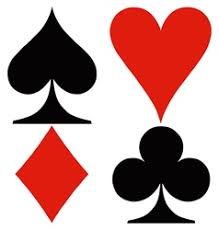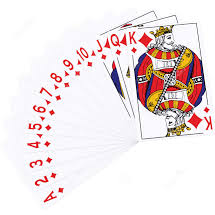Science > Mathematics > Statistics and Probability > Probability > Problems Based on Drawing a Playing Card
In the last few articles, we have seen to solve problems based on tossing of coins, throwing dice, and selecting numbered cards. In this article, we shall study the problems to find the probability involving playing cards.
Introduction to Playing Cards:
Before studying, the problems on playing cards, you should be thorough with the following facts:

- There are 52 playing cards in a pack of playing cards.
- There are four suites in a pack viz: Spade (♠), Club (♣), Diamond (♦), Heart (♥)
- In each suite, there are 13 cards of different Denominations. viz. 1, 2, 3, 4, 5, 6, 7, 8, 9, 10, Jack, Queen and King
- Thus there are 4 cards of each denomination in a pack, like 4 kings, 4 queens, 4 aces, 4 tens, 4 fives, etc.
- Spade and Club are black cards while Diamond and Heart are red cards.
- There are 26 black cards and 26 red cards in a pack.
- Each card is unique in a pack.
- King, Queen, and Jack cards are called picture cards or face cards.
- Thus there are total 12 face cards in a pack. 6 black face cards, 6 red face cards in a pack of playing cards
- There are 3 face cards in each suite.
- The Ace, King, Queen, and Jack of each suit are called honour cards
- The rest of the cards (2, 3, 4, 5, 6, 7, 8, 9, 10 ) are called spot cards.
- Spades and Hearts are called the major suits and Diamonds and Clubs are called the minor suits
Drawing a Single Playing Card From a Pack:
Example – 01:
A card is drawn from a well-shuffled pack of 52 playing cards. Find the probability of getting
Solution:
There are 52 cards in a pack.
one card out of 52 can be drawn by 52C1 ways
Hence n(S) = 52C1 = 52
a) a spade card
Let A be the event of getting a spade card
There are 13 spade cards in a pack
one spade card out of 13 can be drawn by 13C1 ways
∴ n(A) = 13C1 = 13
By the definition P(A) = n(A)/n(S) = 13/52 = 1/4
Therefore the probability of getting a spade card is 1/4
b) a red card
Let B be the event of getting a red card
There are 26 red cards in a pack
one red card out of 26 can be drawn by 26C1 ways
∴ n(A) = 26C1 = 26
By the definition P(B) = n(B)/n(S) = 26/52 = 1/2
Therefore the probability of getting a red card is 1/2
c) a black card
Let C be the event of getting a black card
There are 26 black cards in a pack
one black card out of 26 can be drawn by 26C1 ways
∴ n(C) = 26C1 = 26
By the definition P(C) = n(C)/n(S) = 26/52 = 1/2
Therefore the probability of getting a black card is 1/2
d) a king
Let D be the event of getting a king
There are 4 kings in a pack
one king out of 4 can be drawn by 4C1 ways
∴ n(D) = 4C1 = 4
By the definition P(D) = n(D)/n(S) = 4/52 = 1/13
Therefore the probability of getting a king is 1/13
Note: Probability of getting a card of a particular denomination is always 1/13
e) a red ace
Let E be the event of getting a red ace
There are 2 red aces in a pack
one red ace out of 2 can be drawn by 2C1 ways
∴ n(E) = 2C1 = 2
By the definition P(E) = n(E)/n(S) = 2/52 = 1/26
Therefore the probability of getting a red ace is 1/26
f) a face card
Let F be the event of getting a face card
There are 12 face cards in a pack
one face card out of 12 can be drawn by 12C1 ways
∴ n(F) = 12C1 = 12
By the definition P(F) = n(F)/n(S) = 22/52 = 3/13
Therefore the probability of getting a face card is 3/13
g) a card of denomination between 4 and 10
Let G be the event of getting a card of denomination between 4 and 10
Denominations between 4 and 10 are 5, 6, 7, 8, 9 (total 5 denominations)
Each denomination has 4 cards
Thus there are 5 x 4 = 20 cards of denomination between 4 and 10
one such card out of 20 can be drawn by 20C1 ways
∴ n(G) = 20C1 = 20
By the definition P(G) = n(G)/n(S) = 20/52 = 5/13
Therefore the probability of getting a card of denomination between 4 and 10 is 5/13
h) a red face card
Let H be the event of getting a red face card
There are 6 red face cards in a pack
one face card out of 6 can be drawn by 6C1 ways
∴ n(G) = 6C1 = 6
By the definition P(H) = n(H)/n(S) = 6/52 = 3/26
Therefore the probability of getting a red face card is 3/26.
i) a queen of hearts
Let J be the event of getting a queen of hearts
There is only one queen of heart in a pack
one queen of hearts out of 1 can be drawn by 1way
∴ n(J) = 1
By the definition P(J) = n(J)/n(S) = 1/52
Therefore the probability of getting a queen of hearts is 1/52
j) a queen or a king
Let K be the event of getting a queen or a king
There 4 kings and 4 queens in a pack
Thus there are 4 + 4 = 8 favourable points.
one required card out of 8 favourable points can be drawn by 8C1 ways
∴ n(K) = 8C1 = 8
By the definition P(K) = n(K)/n(S) = 8/52 = 2/13
Therefore the probability of getting a queen or a king is 2/13
k) a red card and a king
Let L be the event of getting a red card or a king
There 2 red cards which are king
Thus there are 2 favourable points.
one required card out of 2 favourable points can be drawn by 2C1 ways
∴ n(L) = 2C1 = 2
By the definition P(L) = n(L)/n(S) = 2/52 = 1/26
Therefore the probability of getting a red card and king is 1/26
l) a red card or a king /a red king
Let M be the event of getting a red card or a king
There 26 red cards (including 2 red kings) and 2 black kings in a pack
Thus there are 26 + 2 = 28 favourable points.
one required card out of 28 favourable points can be drawn by 28C1 ways
∴ n(M) = 28C1 = 28
By the definition P(M) = n(M)/n(S) = 28/52 = 7/13
Therefore the probability of getting a red card or a king (a red king) is 7/13
m) Neither the heart nor the king
Let N be the event of getting neither the heart nor the king
There 36 non-heart cards (excluding 3 kings) in a pack
one required card out of 36 favourable points can be drawn by 36C1 ways
∴ n(N) = 36C1 = 36
By the definition P(N) = n(N)/n(S) = 36/52 = 9/13
Therefore the probability of getting neither the heart nor the king is 9/13
n) Neither an ace nor the king
Let Q be the event of getting neither an ace nor a king
There are 4 aces and 4 kings in a pack
There 44 non-ace and non-king cards in a pack
one required card out of 44 favourable points can be drawn by 44C1 ways
∴ n(Q) = 44C1 = 44
By the definition P(Q) = n(Q)/n(S) = 44/52 = 11/13
Therefore the probability of getting neither ace nor the king is 11/13
o) no diamond
Let R be the event of getting no diamond
There 39 non-diamond cards in a pack
one required card out of 39 favourable points can be drawn by 39C1 ways
∴ n(R) = 39C1 = 39
By the definition P(R) = n(R)/n(S) = 39/52 = 3/4
Therefore the probability of getting no diamond is 3/4
p) no ace
Let T be the event of getting no ace
There are 4 aces in a pack
There 48 non-ace cards in a pack
one required card out of 48 favourable points can be drawn by 48C1 ways
∴ n(T) = 48C1 = 48
By the definition P(T) = n(T)/n(S) = 48/52 = 12/13
Therefore the probability of getting no ace is 12/13.
q) not a black card
Let V be the event of getting no black card
There 26 non-black (red) cards in a pack
one required card out of 26 favourable points can be drawn by 26C1 ways
∴ n(V) = 26C1 = 26
By the definition P(V) = n(V)/n(S) = 26/52 = 1/2
Therefore the probability of getting no black card is 1/2.
In the next article, we shall study some basic problems of probability based on the drawing of two cards from a pack of playing cards.
